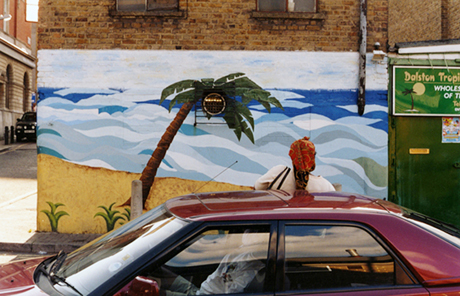Disappearing Dalston

Mural near Ridley Road. Photograph: Catherine Forrest
Documenting the local has become somewhat of an obsession for many artists in recent years. From Tom Hunter’s famed depiction of East End shop-owners and his elegiac meditation on Woodberry Down Estate to Colin O’Brien’s classic take images of Chatsworth Road in Last of the Real High Streets to Stephen Gill’s cerebral dissections of Hackney Wick, pinning down what’s left of ‘old Hackney’ seems to have become a rite of passage for the borough’s photographers.
Catherine Forrest’s Home Is Where the Heart Is and Other Photos from Disappearing Dalston provides a fresh take on this genre.
Dalston is perhaps one of the borough’s most rapidly-changing areas, having shot in the course of a few years from a tucked away inner city neighbourhood to a buzzing brew of hip nightclubs, vintage clothes shops, heaving streets and blocks of luxury flats.
Taken in the early 2000s, Ms Forrest’s photos capture the quirkiness and decidedly lo-fi commercial feel of a locale dominated by small independent shops and market stalls. This is Dalston before the slickness set in, but also before the emergence of the studied dilapidation that characterises so many of the area’s newer venues.
The photos were hand printed from colour negatives printed at Chats Palace community darkroom, on paper appropriately now no longer available.
Ms Forrest, who has lived in Dalston for over 15 years, explains how she came to create this set of works:
“When I started taking the photos I was just trying to capture the look and feel of Dalston, which at that time still had a very particular character of its own. There was a bit of a theme of traces of people missing the places they’d come from, but not all the photos belong to that.
“By the time I came to print the photos it was clear that even if all the things I had photographed had not yet gone, that peculiar character was fast disappearing. This is not any criticism of the buzzy new hipster Dalston, just an attempt to celebrate what was there before”
Some will see in these photos a lost authenticity; more canny viewers may note a hint of irony in the relationship between Dalston’s newly-arrived artists and the rapidly-disappearing urban landscapes so many of them have chosen to document.
Forrest has taken photographs across the world, including Havana, Orissa, the Rhondda. Her work on London includes exhibitions on the Elephant and Castle in abstract colour and black and white portraits from Clerkenwell, shown in the cafes and pubs around the Green where they were taken.
Catherine Forrest: Home Is Where the Heart Is and Other Photos from Disappearing Dalston
1-31 March
Pogo Café
76 Clarence Road
E5 8HB
Tel: 020 8533 1214

this looks fantastic. Even though I never go to Hacney Central (too far east) I wil check this out.
Oh give it a flippin rest. Self-indulgent load of bollox. The same people who ARE changing the face of parts of Hackney, have the audacity to promote their projects lamenting the ‘loss’ ?
One other thing, Ridley Market quirky? To whom?
“elegiac ” – clearly not an article aimed at those who went to a Hackney comprehensive,
@Duchess – indeed. To the new influx = quirky. To a seasoned local = shithole.
Duchess, I took those photos a long long time ago, before anyone had any idea it was all going to change. It was just where I live. And there’s no “lament” involved.
Bollox! If you want to see some proper photos documenting what has been destroyed in Dalston check out the fantastic local photographers called Alan Denney and Chris Dorley Brown Check them out on flickr you won’t be disappointed
Readers may also be interested in our 2009 article on Alan Denney’s Hackney Street Photographs 1978-2008. – Ed.
Having actually seen the photos, I feel I can comment on them rather than merely venting some narrow minded prejudice.
All thing things must pass. No community can remain in aspic. It inevitably evolves over time. What these pictures document is a personal view of this evolution. Not only do the pictures reflect this changing landscape, but their own production has been subject to technological progress. The digital revolution has made the hand-made process as endangered as Dalston itself.
Whatever your own view is of the changing nature of Dalston, these pictures record what has past.
Though, as the previous comments show, others have covered this subject, these pictures offer another personal insight into “Disappearing Dalston” and are well worth a view and even further comment.
Thank you Hamish. I wouldn’t dream of comparing myself to Alan Denney, let alone Colin O’Brien. In any case these are not the same kind of photos. That does not make my work bollocks – might even be worth a look.